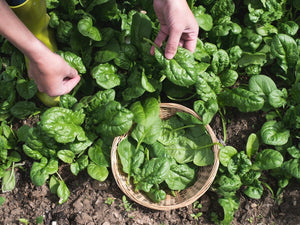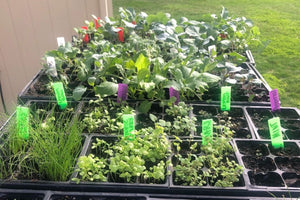The Backyard Gardener's Guide to Growing Cauliflower
CauliflowerWhile you won’t find cauliflower on our list of easiest vegetables to grow from seed, it is delicious and oh-so nutritious. If you’re ready to increase your gardening skills and grow a vegetable that needs some extra attention with a delicious payoff, start growing cauliflower.

Cauliflower is a member of the Brassicaceae family, along with broccoli, kohlrabi, and cabbage. It is also the most temperamental. It needs consistent temperatures and water to form firm, tight heads that have the perfect taste.
Even though cauliflower is a flower, it is best eaten before it has a chance to develop flowers. It is high in vitamins C and K and an excellent source of folate and fiber.
Heirloom Cauliflower Seeds
Snowball Cauliflower (Brassica oleracea) is a heavy yielder producing snowy white 5-7" heads with tightly packed curds. Leaves tend to wrap around the head, protecting it from yellowing in sunlight.
Growing Cauliflower from Seed
Like broccoli and celery, cauliflower takes some planning to grow. We’ll walk you through all the tips you need to start growing cauliflower in your home garden.
You'll want to plan ahead to grow cauliflower in the optimal conditions. For the best harvest, you will need to grow cauliflower when temperatures are between 55º and 80ºF. Cauliflower seeds can be sown outdoors or started indoors.
We recommend starting cauliflower seeds indoors to control temperature, humidity, and light. For spring planting, start cauliflower seeds indoors 4 to 6 weeks before the last frost date. For fall/winter growing, plant seeds 12 weeks before the first fall frost. Allow 50 to 75 days to mature before temperatures are too hot or too cold.
Babying your cauliflower will produce the best head. Water frequently and keep plants well-fertilized. As heads develop, clip leaves together to keep the head snow white.

Tips for fail-proof cauliflower seed germination
Place cauliflower seeds 2 or 3 per hole or cell.
Plant seeds ½” deep.
Keep seeds moist until they germinate in 10 to 15 days.
Cauliflower seeds germinate best in soil temperatures between 60-75ºF
Transplanting Cauliflower Seedlings
Transplanting cauliflower seedlings takes some care so that they develop correctly. The good news is that starting your cauliflower from seed allows you to transplant when the plants are ready and ensures that they haven’t dried out or been stressed. Stressed seedlings will not form tight heads. Follow these transplanting tips for a successful cauliflower harvest.
Transplant before the seedlings become root-bound.
When seedlings are about 4 inches tall and have four leaves, they will be ready for transplanting.
Harden off cauliflower seedlings. Gradually give them more sunlight and cooler nights.
In spring, plant out seedlings 1 to 2 weeks before the last frost date. Cover and protect from frost if necessary.
In fall, transplant cauliflower seedlings outdoors 6 to 8 weeks before the first fall frost.
Transplant on a cloudy, cool day if possible.
Wait until temperatures are above 31ºF at night.
Take care not to disturb roots when transplanting.

How to Grow Delicious Cauliflower
Once your cauliflower seedlings are outdoors, they need consistent tender care. Cauliflower grows best in temperatures between 60 and 80ºF. Cauliflower plants also need consistent water to grow firm heads. Cauliflower that doesn’t form large heads is called buttoning. This is when it forms small button-sized heads instead.

Timing and Temperature
Cauliflower is a cool-weather crop. Fall is the best time to grow cauliflower in many locations since it doesn’t do well in temperatures above 80ºF.
Soil
Plant cauliflower in rich, fertile soil that drains well. The ground needs to hold enough moisture and not dry out completely. Prepare your ground ahead of time with well-rotted compost.
Sun
Cauliflower grows best in full sun. However, it doesn’t like the heat. At a minimum, it needs 6 hours of direct sunlight daily. This means that in hot climates, you might need to plant cauliflower in partial sun to get enough light while limiting the intense heat.

Spacing
Place cauliflower seedlings 12 to 18 inches apart in rows 24” apart. The head is just part of the cauliflower plant. Big leaves will spread out from the plant, gathering up sunlight to produce the edible curds. When spaced too close together, cauliflower plants won’t form heads.
Watering
Keep cauliflower well-watered to avoid stressing the plant. Stress on the plant can lead to small or loose heads. Water consistently, about 1.5 to 2 inches a week.
Fertilizer
First, test your soil before planting cauliflower and make amendments as needed. Cauliflower has high nitrogen needs; extra nitrogen can be added before planting if required. However, don’t over fertilize as this will result in a lot of leaf growth and not head growth.
Mulching
Mulching cauliflower plants has several benefits. Mulch will keep weeds from growing and keep the soil moist and cool. Use natural types of mulch that will help improve the soil.

Blanching
Cauliflower stays white by not getting sunlight on its head. This white head is called the “curd.” The leaves should naturally curl around the growing cauliflower curd. This protection from the sunlight is called blanching. Without blanching, the curd will turn yellowish or brown. If the leaves aren’t shading the cauliflower head when it is 2 to 3 inches wide, you can use string, clothes pins, or rubber bands to hold the leaves around the head. Be careful to leave the leaves a little loose so the cauliflower head still gets some airflow.
Solutions for cauliflower pests and diseases
Aphids, cabbage worms, and flea beetles are the most common pests for cauliflower.
Getting rid of aphids naturally is your first line of defense. Use a strong stream of water to remove the aphids as soon as they are detected.
Picking off worms and wiping away eggs are some of the ways to control worms.
It’s a good gardening practice to rotate crops. Planting cauliflower and other brassicas in different locations every few years can help prevent the build-up of soil pathogens.

Harvesting Cauliflower
Timing your cauliflower harvest just right will give you the best flavor and texture. It’s time to harvest cauliflower when the head is still tight and before it has started loosening. When the curd begins loosening, it is starting to flower. When this happens, you’ll notice a change in texture and flavor.
To harvest cauliflower, cut off the head with a sharp knife below the first few close leaves. Cauliflower will stay fresh in the fridge for about a week.
Cauliflower FAQs
What is the secret to growing cauliflower?
The secret to growing cauliflower is temperature and light. These factors determine the size, texture, and taste.
How long does it take to grow cauliflower?
Cauliflower takes some patience. Depending on the variety, it can take 3 to 6 months to grow. It’s usually 75 to 85 days to harvest from transplanting.
Is cauliflower difficult to grow?
Cauliflower needs consistent temperature and moisture for optimal growth. Growing cauliflower in gardening zones that fluctuate in temperatures outside of 60º-80ºF takes some extra care.
What month do you plant cauliflower?
Consider your gardening zone and plant cauliflower when it can grow and form heads when temperatures are between 60º and 80ºF.

Cauliflower may not be the easiest vegetable to grow, but it is worth the effort for this delicious, healthy harvest. With the tips in this growing guide, you are ready to take on a gardening challenge that will make you feel like a master gardener.
And remember, gardening takes practice. Every year is a little different with weather and growing conditions. So sharpen your gardening skills and learn how to grow cauliflower from seed.
Written by Beverly Laudie
Found this information helpful? Share it with a gardening friend!







Leave a comment